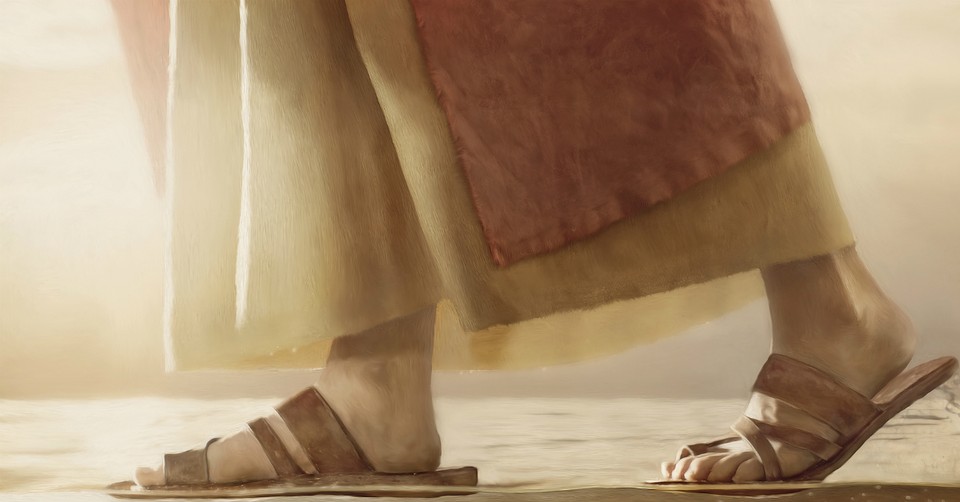4 Lessons from Peter Walking on Water

As fishermen by trade, most of Jesus’ disciples would have grown up on the Sea of Galilee and known it very well. They would have had insider knowledge of all the good fishing spots, become familiar with Galilee’s tide and weather patterns, and mastered the ability to navigate a small boat across the lake with a certain level of proficiency… or so they thought. Despite their vocational expertise, no amount of seamanship or local knowledge could have prepared any of the disciples for the handful of literal and figurative storms that threatened their lives and tested their faith.
On two separate occasions, the disciples of Jesus were overcome with fear when their boat was caught in a storm on the very lake they called home; and in both instances, Jesus came to their rescue. In one story, found in Matthew 14:28-33, Mark 6:45-52, and John 6:16-24, not only did the Twelve witness the supernatural power of Jesus Christ as he walked on water to meet them, that night, one of their own stepped out of the boat to walk with Jesus on the waves. I’m referring, of course, to Peter, who became one of just two humans in history to actually walk on water.
A lot has been written about this short but iconic chapter in the ministry of Jesus. Entire sermons have been devoted to the disciples’ fear and Peter’s lapse in faith, but what really happened on that stormy night, and what can we learn from Peter’s miraculous walk with Jesus on the Sea of Galilee?
Here Are 4 Lessons from the Story of how Peter Walks on Water
1. Peter Walks on Water Lesson: Jesus Is Not Blind to or Removed from Our Struggle
In the second sea adventure that nearly sunk the disciples, both literally and spiritually, Jesus had sent his disciples ahead to the other side of the lake while he went up on the mountain alone to pray (Matthew 14:23). This took place following the death of John the Baptist and the Feeding of the Five Thousand, which happened earlier that day (Matthew 14, Mark 6, John 6). Why is this important? Because despite the disciples’ general feelings of abandonment and despair, Matthew’s gospel reminds us that Jesus had “made the disciples get into the boat” and go on to the other side of the lake without him (Matthew 14:22).
Did Jesus need a break from his annoying disciples? Was he trying to rid himself of his often faithless friends? Was Jesus as apt at predicting the weather as a modern-day weatherman? Did he call down the storm? I would argue no to all four scenarios. So why did Jesus send his disciples into a treacherous storm at the end of a long day?
We know that Jesus frequently went off alone to pray. Following the death of his cousin and a full day of ministry, it makes sense that he would make time to reflect and recover his strength. We should remember also that Jesus had performed one of his most public miracles even after learning that his cousin had been killed. In a time of personal grief, Jesus still chose to minister. He never turned away from the struggle of those he loved or forgot about those he was called to serve, including his disciples. But while his disciples struggled, Jesus prayed.
What was he praying about? Who was he praying for? Could he have been praying for his disciples? We don’t know. But in the midst of the storm, as the waves spilled over the edges of the disciples’ boat and the winds pushed the Twelve in every direction except the direction they wanted to go, from their perspective, it may have felt like Jesus had abandoned or forgotten them altogether. The first time the disciples were caught in a storm, the Twelve turned to Jesus and asked, “teacher, don’t you care if we drown?” (Mark 4:38) That was with Jesus in the boat. Where was Jesus when they needed him most?
We too may feel this way when we are caught in the middle of life’s greatest storms or feel like we’re beginning to sink. Has God forgotten or abandoned us? Does he even care if we sink or drown? It’s easy to become fearful and lose faith when we’re tired, frustrated, or alone. But while the disciples fought to stay afloat, not only did Jesus pray, he saw their struggle (Mark 6:48). He never lost sight of those he loved. More importantly, he had a plan to deliver them from what probably felt like their darkest night and came through on his promise. Jesus knew what his disciples would encounter on the Sea of Galilee. He sent them anyway. What should that tell us about our current struggles?
In one of the darkest hours of Israel’s history, the prophet Jeremiah wrote that God knows the plans he has for us. They are “plans to prosper you and not to harm you, plans to give you hope and a future.” (Jeremiah 29:11) Could it be that sometimes God’s plans for us include the storms of life? When Jesus met the disciples on the waves, he immediately said, “take courage! It is I. Don’t be afraid” (Matthew 14:27). Jesus was never blind to or removed from his disciples’ situation. Jesus knew exactly where there were and knew when he would intervene and how he would do it. He was never far and never turned his eyes away from his followers. The same is true for us today (Psalms 34:18).
2. Miracles Happen When We Are Willing to Step Out in Faith
Unfortunately for the disciples, a journey by boat across the Sea of Galilee that should have taken an hour or two at most, lasted anywhere from six to twelve hours because of the wind and the weather. And by the time Jesus met them on the water, they hadn’t even reached the center of the lake. Mark’s gospel even tells us that Jesus, walking on foot, could have passed the disciples in their boat (Mark 6:48). Consider that! Jesus was walking faster than they were rowing. The disciples had been rowing for hours and barely gotten anywhere.
Can you imagine the fatigue and frustration that must have set in for this weary group of seasoned fishermen who no could no longer rely on their strength, skill, or expertise to see them through this particular storm? How many times had Peter, Andrew, James, and John encountered a situation on the Sea of Galilee they couldn’t handle? Maybe that was the point. For hours, the disciples had exhausted themselves trying to get themselves out of trouble. Only after Jesus had arrived did they find any reprieve from their storm (Matthew 14:32).
This is where Peter made a critical decision. Continue to struggle in a boat of their making or turn to Jesus for help and relief? Peter decided it was better to be in a storm with Jesus that continue doing things the same way without him; and for his faith, Peter not only got to observe a miracle, he got to experience one firsthand by daring to get out of the boat and walk to his lord. Sometimes the greatest miracles of life happen when we too are willing to step out in faith and surrender to God’s power instead of relying on our own. God has a way of parting waters and calming seas when we do.
As it is written, “trust in the Lord with all your heart and lean not on your own understanding; in all your ways submit to him, and he will make your paths straight.” (Proverbs 3:4-5)
3. Peter Walks on Water Lesson: Faith Requires Focus
Once Peter stepped out of the boat, he too could walk on water by Christ’s power at work within him. However, Matthew writes that “when he (Peter) saw the wind, he was afraid and, beginning to sink, cried out, ‘Lord, save me!’” (Matthew 14:30). When Peter took his eyes off of Jesus and focused more on the dangers around him, he began to sink. So do we.
Jesus warned his disciples and future followers that “in this world you will have trouble. But take heart! I have overcome the world” (John 16:33). When we keep our eyes on Jesus, we connect to the true source of all peace, power, hope, and perspective. When we focus on our storms or impossible circumstances, the world becomes a truly terrifying place; and that fear can be overwhelming. Faith, like hope or peace or joy, requires focus. It too can be lost or shaken if not protected.
The apostle Paul wrote, however, that “since, then, you have been raised with Christ, set your hearts on things above, where Christ is, seated at the right hand of God. Set your minds on things above, not on earthly things” (Colossians 3:1-2). Jesus also told his disciples to, “seek first his kingdom and his righteousness, and all these things will be given to you as well. Therefore do not worry about tomorrow, for tomorrow will worry about itself. Each day has enough trouble of its own” (Matthew 6:33-34).
A lot has been written about Peter’s lapse in faith in the moment that caused him to sink, but let’s not forget, of the twelve disciples, who else was willing to get out of the boat? Who else had enough faith to brave the waves and walk to Jesus? Jesus challenged Peter’s doubt (Matthew 14:21) and often challenged his disciple’s lack of faith during his ministry, which is why he said, “truly I tell you, if you have faith as small as a mustard seed, you can say to this mountain, ‘Move from here to there,’ and it will move. Nothing will be impossible for you.” (Matthew 17:20) Peter got a taste of that power the moment he got out of the boat.
4. Worship Is an Antidote to Anxiety
The story of Jesus (and Peter) walking on water took place mere months after Jesus had calmed the seas while on a boat with his disciples (Matthew 8:23-27, Mark 4:35-41, Luke 8:22-25). Begging Jesus to intervene, the disciples woke Jesus in panic. Luke writes that “he (Jesus) got up and rebuked the wind and the raging waters; the storm subsided, and all was calm. ‘Where is your faith?’ he asked his disciples” (Luke 8:24-25). About the disciples, Matthew notes, “the men were amazed and asked, ‘What kind of man is this? Even the winds and the waves obey him!” (Matthew 8:27)!
After the first storm, the disciples asked the question. In the second storm, they found their answer. “Then those who were in the boat worshiped him, saying, ‘Truly you are the Son of God’” (Matthew 14:33). Perhaps this was the reason for the second storm. By the time Jesus walked on water and calmed the seas, the disciples had already witnessed several public miracles. In fact, just hours before, Jesus had challenged their same lack of faith when he multiplied five loaves and two fish to feed five thousand people (Matthew 14:13-21). Had they forgotten who Jesus was so soon?
Unfortunately, yes. Mark writes that “they had not understood about the loaves; their hearts were hardened” (Mark 6:52). When we forget the goodness of God, forget his promises, and forget the miracles he has already performed in our lives, not only do we, like Peter, begin to sink, our storms intensify. Worship, however, becomes the antidote to anxiety, worry, fear, and doubt. In his storms, David rejoiced. In their deliverance, the disciples praised God. When God is elevated, so are our spirits.
On the Sea of Galilee, the disciples of Jesus may have lost faith. It wouldn’t be the last time they’d forget who Jesus really was. That night, however, something had changed. Not only would this be a turning point in their perspective of Jesus, but for Peter, his walk was an experience he would never forget. And as it turns out, courage, like fear, can become contagious. It only grows the more it is tested.
Further Reading:
How Did Peter Walk on Water? & Why Did He Sink?
Jesus Walks on Water - Bible Story
Photo credit: ©GettyImages/KristiLinton

Originally published February 01, 2021.





